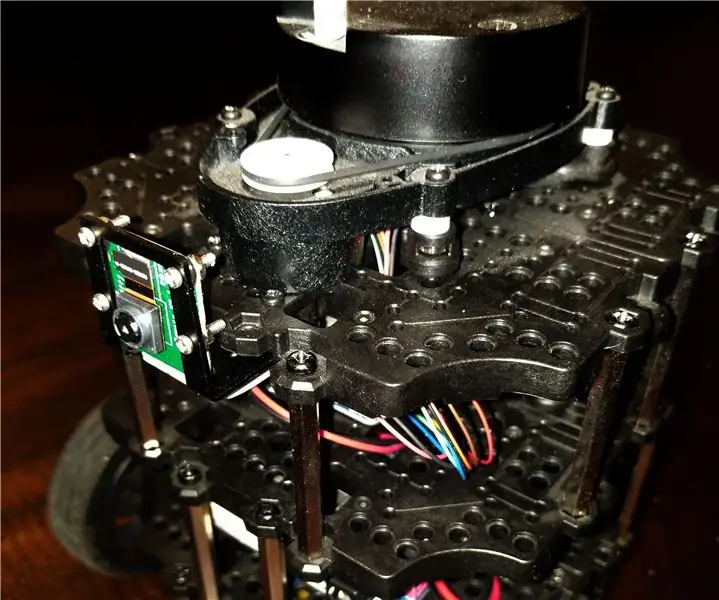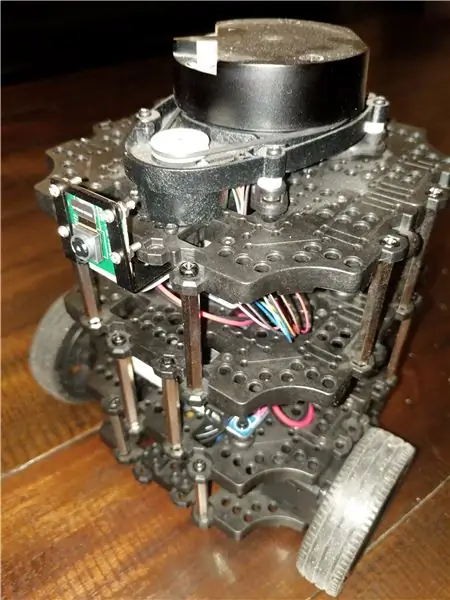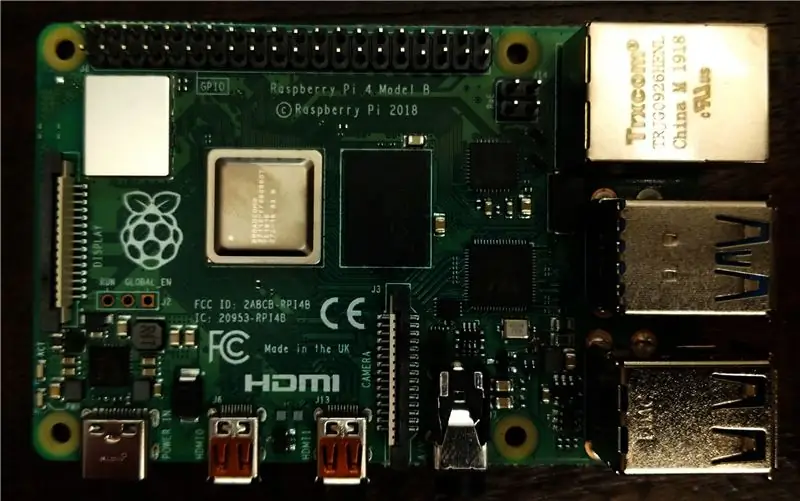
Tabla de contenido:
- Autor John Day [email protected].
- Public 2024-01-30 08:40.
- Última modificación 2025-01-23 14:39.

TurtleBot3 Burger viene con Raspberry Pi 3 B / B + y no es compatible con la nueva (a fecha de 9/2019) Raspberry Pi 4b. Siga los pasos a continuación para que TurtleBot3 funcione en Raspberry Pi 4b, incluido
- construyendo ROS Kinetic a partir de fuentes en Raspberry Pi 4b Raspbian Buster
- agregar paquetes específicos de TurtleBot3
- agregando raspicam-node a
Paso 1: Instale Raspbian y configure Raspberry Pi 4b

Descarga una imagen de Raspbian. Usé Raspbian Buster con fecha de 2019-07-10.
Grabe la imagen de Raspbian descargada en una tarjeta SD (al menos 8 Gb de tamaño). Conecte una pantalla, teclado y mouse a su Raspberry Pi 4b, arranque y conéctese a WiFi. Extienda el sistema de archivos para ocupar toda su tarjeta SD y, opcionalmente, habilite SSH y VNC ejecutando
sudo raspi-config
Paso 2: Descarga ROS Kinetic Sources

Las instrucciones a continuación siguen el tutorial oficial de ROS, así como el instructable de DmitryM8.
Inicie sesión en su Raspberry Pi 4b y ejecute estos comandos para agregar el repositorio de paquetes ROS, construir herramientas e inicializar la herramienta de dependencia ROS.
sudo sh -c 'echo "deb https://packages.ros.org/ros/ubuntu $ (lsb_release -sc) main"> /etc/apt/sources.list.d/ros-latest.list'
sudo apt-key adv --keyserver 'hkp: //keyserver.ubuntu.com: 80' --recv-key C1CF6E31E6BADE8868B172B4F42ED6FBAB17C654 sudo apt-get update sudo apt-get install -y python-rosdep python-rosinstall-generator python-wstool python-rosinstall build-essential cmake sudo rosdep init rosdep update
Cree un espacio de trabajo para construir ROS Kinetic desde la fuente.
mkdir ~ / ros_catkin_ws
cd ~ / ros_catkin_ws
Descargue el código fuente del paquete "ros_comm", que contiene módulos esenciales destinados a ejecutarse en la computadora de a bordo del robot. Aquí rosinstall_generator crea una lista de repositorios de código fuente para descargar. wstool luego procede a descargar el código fuente.
rosinstall_generator ros_comm --rosdistro kinetic --deps - solo húmedo --tar> kinetic-ros_comm-wet.rosinstall
wstool init -j8 src kinetic-ros_comm-wet.rosinstall rosdep install --from -path src --ignore-src --rosdistro kinetic -y
Para ejecutar TurtleBot3 y raspicam, necesitará estos paquetes ROS además de ros_comm: common_msgs, rosserial, image_common, image_transport_plugins y diagnostics. Para agregar estos paquetes, ejecute estos comandos.
rosinstall_generator common_msgs common_msgs rosserial image_common image_transport_plugins diagnóstico nodelet_core --rosdistro kinetic --deps --wet-only --tar> kinetic-extra-wet.rosinstall
wstool merge -t src kinetic-extra-wet.rosinstall wstool update -j8 -t src rosdep install --from -path src --ignore-src --rosdistro kinetic -y
A medida que las versiones de las dependencias cambian con el tiempo, puede haber errores como "python-rosdistro-modules_0.7.5-1_all.deb (--unpack): intentando sobrescribir '/usr/lib/python2.7/dist-packages/rosdistro/_init_.py ', que también está en el paquete python-rosdistro 0.7.2-1 ". Resuelva estos errores de "intentar sobrescribir":
sudo dpkg --remove --force-all python-catkin-pkg python-catkin-pkg-modules python-rosdistro python-rosdistro-modules python-rospkg python-rospkg-modules
// o sudo apt eliminar sudo apt --fix-broken install
Paso 3: corregir manualmente los errores de compilación de ROS

La construcción de ROS en este punto fallará con varios errores. Arreglemos esos errores editando manualmente el código fuente de ROS.
Editar
/home/pi/ros_catkin_ws/src/opencv3/modules/python/src2/cv2.cpp línea 885
Reemplazar
char * str = PyString_AsString (obj);
con
const char * str = PyString_AsString (obj);
Edite los archivos a continuación.
/home/pi/ros_catkin_ws/src/rospack/include/rospack/rospack.h /home/pi/ros_catkin_ws/src/rospack/src/rospack.cpp /home/pi/ros_catkin_ws/src/rospack/src/utils.cpp
Eliminar todas las apariciones de
/ tr1
y reemplazar todas las apariciones de
std:: tr1
con
aumentar
Edite los archivos a continuación.
/home/pi/ros_catkin_ws/src/actionlib/include/actionlib/client/simple_action_client.h /home/pi/ros_catkin_ws/src/actionlib/include/actionlib/destruction_guard.h / home / pi / rosc_catkin_ws / sr. /actionlib/server/simple_action_server_imp.h /home/pi/ros_catkin_ws/src/actionlib/src/connection_monitor.cpp /home/pi/ros_catkin_ws/src/actionlib/test/destruction_guard_test.cpp / bond_wscore / /bondcpp/src/bond.cpp /home/pi/ros_catkin_ws/src/ros_comm/roscpp/include/ros/timer_manager.h /home/pi/ros_catkin_ws/src/ros/roslib/test/utest.cpp
Reemplazar todas las ocurrencias de
boost:: posix_time:: milisegundos (…)
con
boost:: posix_time:: milisegundos (int (…))
Edite el archivo a continuación.
/home/pi/ros_catkin_ws/src/geometry2/tf2/src/buffer_core.cpp
Reemplaza todo
logWarn
con
CONSOLE_BRIDGE_logWarn
y
logError
con
CONSOLE_BRIDGE_logError
Paso 4: Construya ROS Kinetic
En este punto, la compilación debería realizarse correctamente.
cd ~ / ros_catkin_ws
sudo./src/catkin/bin/catkin_make_isolated --install -DCMAKE_BUILD_TYPE = Liberar --install-space / opt / ros / kinetic
Agregue a ~ /.bashrc y también ejecute en su shell:
fuente /opt/ros/kinetic/setup.bash
Paso 5: Construya los paquetes TurtleBot3 y Raspicam

Estas instrucciones siguen el tutorial de ROBOTIS.
mkdir -p ~ / catkin_ws / src
cd ~ / catkin_ws / catkin_make fuente devel / setup.bash
Edite ~ /.bashrc y agregue
fuente /home/pi/catkin_ws/devel/setup.bash
Ahora, ejecuta
cd ~ / catkin_ws / src
clon de git https://github.com/ROBOTIS-GIT/hls_lfcd_lds_driver.git clon de git https://github.com/ROBOTIS-GIT/turtlebot3_msgs.git clon de git https://github.com/ROBOTIS-GIT/turtlebot3. git git clone https://github.com/UbiquityRobotics/raspicam_node.git cd ~ / catkin_ws / src / turtlebot3 rm -r turtlebot3_description / turtlebot3_teleop / turtlebot3_navigation / turtlebot3_slam / turtlebot3_example / cd& / catkin_make
La construcción debería tener éxito.
Configure Raspberry Pi 4b para reconocer los periféricos USB TurtleBot3.
rosrun turtlebot3_bringup create_udev_rules
Ejecute ifconfig y anote la IP de Raspbery Pi.
ifconfig
Edite ~ /.bashrc. Agregue las líneas a continuación y también ejecútelas en su shell.
exportar ROS_MASTER_URI = https://YOUR. ROS. MASTER. IP: 11311
exportar ROS_HOSTNAME = YOUR. RASPBERRY. PI. IP
Sincronice la hora de la Raspberry Pi y la PC:
sudo apt-get install ntpdate
sudo ntpdate ntp.ubuntu.com
En este punto, su configuración debería estar completa. Ahora puede usar su Raspberry Pi 4b en lugar de Raspberry Pi 3/3 + en su TurtleBot3.
Recomendado:
¡Instale Windows 10 completo en una Raspberry Pi !: 5 pasos

¡Instale Windows 10 completo en una Raspberry Pi !: La Raspberry Pi es una gran placa para hacer muchas cosas. Hay muchos instructivos sobre cosas como IOT, automatización del hogar, etc. En este instructivo, le mostraré cómo puede ejecutar el escritorio completo de Windows en su Raspberry PI 3B
Instale Ubuntu 18.04.4 LTS en su placa Raspberry Pi: 8 pasos

Instale Ubuntu 18.04.4 LTS en su placa Raspberry Pi: El equipo de Ubuntu lanzó el sistema operativo Ubuntu 18.04.4 Long Term Support para computadoras Raspberry Pi 2/3/4 ARM de placa única. distro, que es el sistema operativo oficial de Raspber
Instale el sistema operativo Raspbian en Raspberry Pi 4:24 pasos

Instale el sistema operativo Raspbian en Raspberry Pi 4: Este es el primer tutorial de la serie Raspberry Pi Preparación del contenido: Dr. Ninad Mehendale, Sr. Amit Dhiman La instalación del sistema operativo Raspbian en Raspberry Pi es uno de los pasos más básicos que uno debe conocer. Presentamos un sencillo procedimiento paso a paso para
Instale Homebridge en Raspberry Pi y Windows: 9 pasos

Instale Homebridge en Raspberry Pi y Windows: este tutorial es para personas que quieren instalar Homebridge en Raspberry Pi y Windows. Inicialmente, este tutorial fue escrito en portugués aquí en Brasil. Hice lo mejor que pude para escribirlo en inglés. Así que perdóname por algunos errores que podrían estar al escribir
Instale RockBox en un iPod (pasos sencillos): 6 pasos

Instale RockBox en un iPod (Pasos sencillos): ¡En este instructivo le mostraré cómo instalar RockBox, un sistema operativo de código abierto para iPod! Lo primero es lo primero: la instalación de RockBox anulará su garantía. Además, no soy responsable de ningún daño y / o pérdida de datos que se produzca al instalar RockBo
